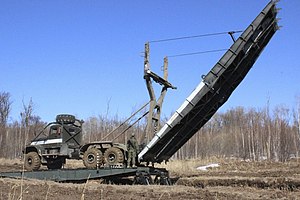TMM-3
| TMM-3 | |
|---|---|

A TMM-3 bridge laying vehicle of the Russian Army (2017) |
|
| General properties | |
| crew | 2 |
| length | 9.3 m (vehicle with bridge) |
| width | 3.2 m (vehicle with bridge) |
| height | 3.4 m (vehicle with bridge) |
| Dimensions | 20.4 tons |
| Armor and armament | |
| Armor | unarmored |
| Main armament | unarmed |
| Secondary armament | unarmed |
| agility | |
| drive | Eight cylinder diesel engine JaMS-238 240 PS (176.5 kW) |
| Top speed | 60 km / h (road) |
| Power / weight | |
| Range | 530 km (road) |
The TMM-3 ( Russian ТММ-3, тяжёлый механизированный мост 3 , in German: " heavy mechanized bridge 3 ") is a military rapid bridge system from Soviet production and conceptually comparable to the nature of bridge-laying tanks. However, only off-road wheeled vehicles are used with the TMM-3 system. The TMM-3 system was introduced into the Soviet Army in the 1970s, replacing the TMM system, which was based on the outdated KrAZ-214 .
technology
The rapid bridge system consists of four bridge laying vehicles on the 6 × 6 chassis of the KrAZ-255 B or KrAZ-255B1, which is equipped with a special mechanism for unfolding and laying out a bridge segment that is carried on the truck. Four such KrAZ-255B vehicles belong to a complete bridge set. A fully deployed bridge has a length of 10.5 m, the height of the supporting pillars can be adjusted between 1.7 and 3.0 m. When a complete set of four 10.5-meter individual bridges has been completed, the result is a total bridge length of 42 meters. The completion of the construction process of a complete express bridge takes around 72 minutes. The transfer structure is designed for caterpillar and wheeled vehicles up to 60 tons.
After the collapse of the Soviet Union, the manufacturer KrAZ of the base vehicle was located in the newly founded Ukraine , and production of the KrAZ-255 was discontinued in the early 1990s. After the reliable TMM-3 rapid bridge system was still used in Russia , the changeover to other laying and transport vehicles took place in the period that followed. One variant used the Ural-4320 as a laying vehicle, another the KamAZ-53501 . However, both attempts at modernization have so far not been successful and these variants have temporarily not been introduced into the military. Other significantly more modern rapid bridge systems with a similar concept are coming into focus, for example the more powerful TMM-6 system based on the heavy 8 × 8 truck MZKT-7930 “Astrolog” .
variants
The individual variants do not differ in terms of bridge-laying technology, but only in terms of the basic vehicles.
- TMM-3M1: KrAZ-260 - Chassis
- TMM-3M2: KamAZ-5350 chassis
- TMM-3M: Ukrainian variant based on the KrAZ-6322 or KrAZ-6446 models , presented in 2016 and 2017.
commitment
In addition to the Soviet Army, the TMM-3 system was used in a number of other armies, primarily in the Warsaw Pact armed forces . In the National People's Army (NVA) of the GDR it was used as the "Heavy Mechanized Bridge TMM-3". There were also exports to Finland .
Technical specifications
| vehicle | Complete sentence | |
|---|---|---|
| crew | 2 men | 8 men |
| Bridge length | 10.5 m (one segment) | 42 m (four segments) |
| Bridge width | 3.8 m | |
| Track width | 1.5 m | |
| Load-bearing capacity of the bridge | 60 tons | |
| Height of the bridge | 1.7 m (minimum) to 3.2 meters (maximum) | |
| Time to move | 15 min (one segment) | maximum 45 to 60 min (four segments) |
| Maximum speed on the bridge | 30 to 35 km / h | |
Web links
- Description and technical data of the TMM and TMM-3 systems (Russian)
- TMM-3 in the offer of the Belarusian armaments company Belspezwneschtechnika (English)
Individual evidence
- ^ A b c d Russell Phillips: Combat Engineering Equipment of the Warsaw Pact. Shilka Publishing, 2017.
- ^ Department of the Army [DoD], Headquarters: Engineer Combat Operations, Part 101. 1979. Page 23.
- ↑ ремонтування та технічне обслуговування машин і устатковання спеціальної призначення (33.12.2), послуги з ремонту і технічного обслуговування техніки (50530) (ремонт за технічним станом інженерної техніки - ТММ-3М (Ukrainian)

